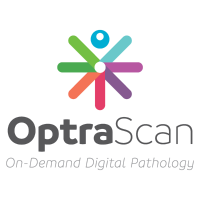Advisory Board Applauds On-Demand Approach of OptraSCAN
 OptraSCAN has given tissuepathology.com a rare insight into their advisory board discussions as to what their thought leaders think is important in the digital pathology space for the market.
OptraSCAN has given tissuepathology.com a rare insight into their advisory board discussions as to what their thought leaders think is important in the digital pathology space for the market.
OptraSCAN is of course the first On-Demand digital pathology company that includes a small footprint, high and low throughput WSI scanner OptraSCANTM (that facilitates brightfield, fluorescent and frozen section/live view scanning), an integrated image viewer and image management system ImagePathTM and telepathology TELEPathTM, image analysis OptraASSAYSTM and CARDSTM (computer aided region detection system), and includes up to 10 TB of complimentary cloud storage.
Among many potential areas of development & marketability, advisors see innovation and value in On-Demand solutions to increase productivity and efficiency across pathology labs and academic institutions:
- Labs can compete with larger lab networks by reducing TAT with cloud-enabled scanners and remote viewing
- On-Demand LIMS easily interfaces into existing LIMS for easy implementation of image management and downstream analysis
- Real-time need for mobile apps to review cases for sample adequacy
- Oncologists can utilize the scanner and software for FDA approved algorithms
- Machine interpretation is more consistent with itself than human
Image analysis, improved workflow in clinical and pre-clinical environments as well as deep learning top the list.
One item of particular interest to me is reference to oncologists using scanners and FDA approved algorithms for their use. This is an area I have given quite a bit of thought too if not shared on this site before. What about having our oncology colleagues use our technologies?
Should they? Would they? Is there a parallel in radiology perhaps where oncologist can analyze digital images? Can they? Do they?
While I think this is going to happen, at the insistence of oncologists and pathologists and laboratories will have to deal with this – it will be some time but I think oncologists are an important piece in getting digital pathology adopted in hospital laboratories.
For now, in my experience, most clinicians, including oncologists are content with getting the right answer in a timely manner. There is little regard whether the pathologist is right- or left-handed, if we use a Leica, Nikon, Olympus or Zeiss microscope, if we microwave process the tissue or prepare it overnight, if the lab is xylene-free and so on.
But the oncologist is an important part of the equation to get this technology deployed, in my opinion, convincing laboratory leaders and hospital administrators on the value of digital pathology. The ability to review images with patients, portability of those images, ability to review prior and current material for review and tumor boards and teach the pathologists and oncologists of tomorrow to embrace digital imaging.
And over time oncologists will want to share these images and further analyze them. They will want to see the tissue and perform some image analytics and perhaps some modeling with response to therapies. They will want to see what proportion of cells are PD-L1 positive and perhaps even how many lymphocytes there are within a tumor and how close they are to a tumor and so forth.
Pathologists will have to be sure to keep these images within our domain but much like other data in healthcare, providers will require the ability to review those images at the bedside to have the relevant data at their fingertips to provide care.
And this may include oncologists using algorithms in real-time at the bedside from the tissues we process, stain and scan.
Desktop scanning and desktop reviews – from pathologist to patient will provide another added value for digital pathology. For too long the pathologist has been behind the “paraffin curtain”. This provides us an opportunity to more directly interact with patients and their physicians by providing our images and expertise directly in the clinic. Pathologists will have to become accustom to sharing images derived from slides and slide-based assays that will be accessible to patients. But in the end, will showcase our specialty and our skills and their impact on patient care.
I just hope personalized medicine remains a shared art and is not lost from the laboratory.

































